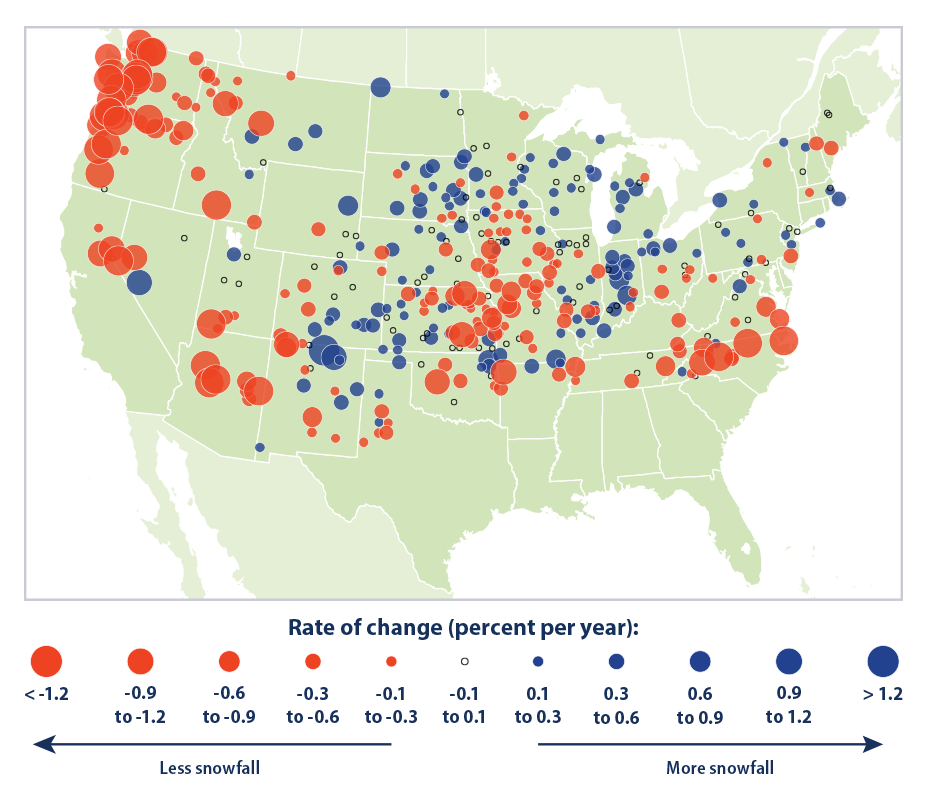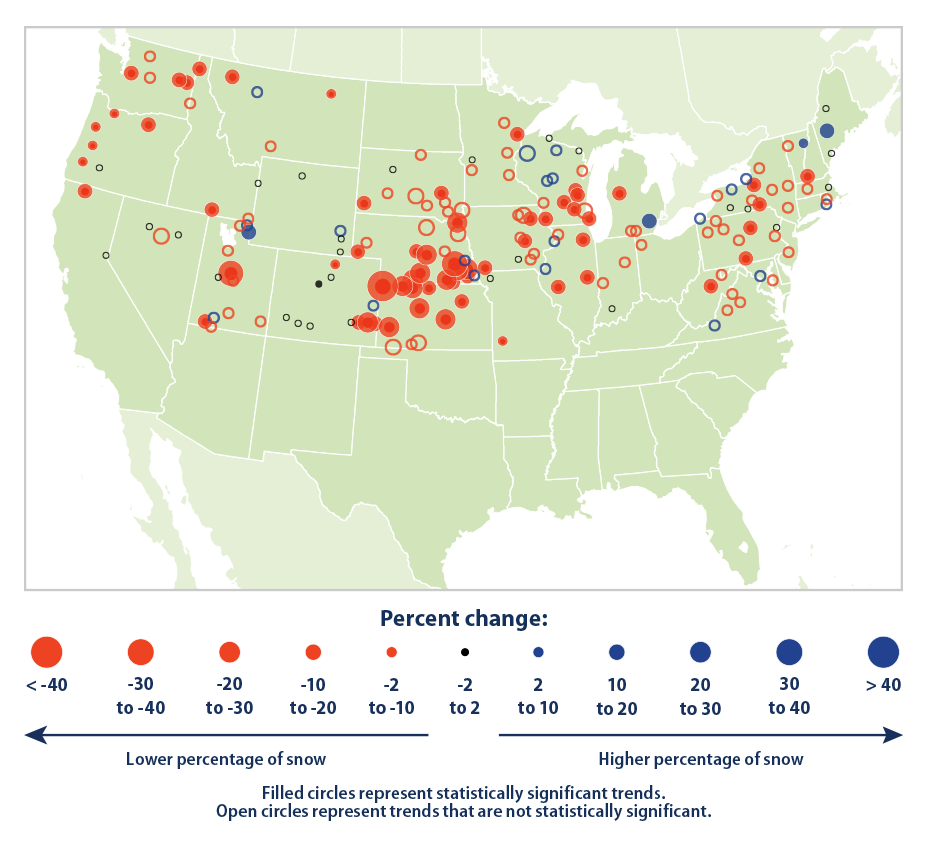what reference source would you use to find the average snowfall in january in nome alaska
This indicator uses two unlike measures to show how snow has changed in the contiguous 48 states.
-

This figure shows the boilerplate rate of change in full snowfall from 1930 to 2007 at 419 atmospheric condition stations in the face-to-face 48 states. Blue circles correspond increased snowfall; reddish circles stand for a decrease.
Data source: Kunkel et al., 20092
Web update: May 2014 -

This effigy shows the percentage change in winter snowfall-to-precipitation ratio from 1949 to 2020 at 177 weather condition stations in the contiguous 48 states. This ratio measures what pct of total winter precipitation falls in the grade of snowfall. A decrease (red circle) indicates that more atmospheric precipitation is falling in the form of rain instead of snow. Solid-color circles correspond stations where the trend was statistically significant.
Data source: NOAA, 2021three
Web update: April 2021
Key Points
- Full snow has decreased in many parts of the state since widespread observations became bachelor in 1930, with 57 per centum of stations showing a pass up (see Effigy 1). Amongst all of the stations shown, the average change is a decrease of 0.19 percent per year.
- In addition to changing the overall rate of precipitation, climate change tin lead to changes in the blazon of precipitation. Ane reason for the decline in total snowfall is because more than winter atmospheric precipitation is falling in the form of rain instead of snow. Near fourscore per centum of the stations across the contiguous 48 states have experienced a decrease in the proportion of precipitation falling as snow (run into Effigy two).
- Snow trends vary past region. The Pacific Northwest has seen a decline in both total snowfall and the proportion of atmospheric precipitation falling as snow. Parts of the Midwest have also experienced a decrease, particularly in terms of the snowfall-to-precipitation ratio. A few regions have seen modest increases, including some areas near the Dandy Lakes that at present receive more snow than in the past (see Figures 1 and 2).
Background
Snowfall is an important aspect of winter in much of the Usa. Many people depend on snow to provide water when information technology melts in the leap, including millions of people in the western United States, where snowmelt provides 75 percent of the water supply.1 Many communities also rely on snowfall for wintertime recreation. Some plants and animals also depend on snowfall and snowmelt for survival. The amount of snow that falls in a particular area directly influences both snow cover and snowpack, which refer to snow that accumulates on the basis (run into the Snow Cover indicator and the Snowpack indicator).
Warmer temperatures cause more water to evaporate from the land and oceans, which leads to more atmospheric precipitation, larger storms, and more variation in precipitation in some areas. In general, a warmer climate causes more of this precipitation to fall in the form of pelting instead of snowfall. Some places, even so, could encounter more than snow if temperatures rise only even so remain below the freezing indicate, or if storm tracks modify. Areas near large lakes might as well experience more snowfall as lakes remain unfrozen for longer periods, allowing more water to evaporate. In contrast, other areas might experience less snow as a result of wintertime droughts.
Changes in the corporeality and timing of snow could touch the spawning of fish in the spring and the amount of water bachelor for people to use in the spring and summer. Changes in snowfall could also affect winter recreation activities, like skiing, and the communities that rely on these activities.
Near the Indicator
This indicator tracks total snowfall equally well as the percentage of precipitation that falls in the form of snow versus pelting. These data were collected from hundreds of atmospheric condition stations across the contiguous 48 states.
Total snowfall is adamant past the tiptop of snow that accumulates each day. These measured values unremarkably appear in weather reports (for example, a storm that deposits x inches of snow). Figure i shows how snowfall accumulation totals changed betwixt 1930 and 2007 at more 400 weather stations. These stations were selected because they had loftier-quality information for this entire time period. EPA continues to work on identifying an appropriate method of analysis for updating this indicator.
Figure 2 shows trends in the proportion of total precipitation that falls in the form of snow during each winter season. This is called the "snow-to-precipitation" ratio, and it is based on comparing the amount of snowfall with the total amount of atmospheric precipitation (snowfall plus rain) in each twelvemonth. For this comparison, snowfall has been converted to the equivalent amount of liquid h2o. These information are bachelor from 1949 to 2020.
Almost the Data
Indicator Notes
Several factors brand it hard to measure snowfall precisely. The snow accumulations shown in Effigy i are based on the use of measuring rods. This measurement method is subject to human mistake, as well as the furnishings of wind (drifting snow) and the surrounding environment (such as tall trees). Similarly, snowfall gauges for Figure 2 may grab less snow than pelting because of the effects of wind. Steps accept been taken, even so, to limit this indicator to weather stations with the most consistent methods and the highest-quality information.4 Every bit a result, some parts of the country accept a higher station density than others.
Both figures are limited to the winter flavour. Figure 1 comes from an analysis of Oct-to-May snowfall, while Figure two covers November through March. Although these months business relationship for the vast majority of snowfall in well-nigh locations, this indicator might non represent the entire snowfall season in some areas. About of the data shown for mountainous regions come from lower elevations (towns in valleys) because that is where weather stations tend to exist located.
Data Sources
This indicator shows trends based on two sets of weather records nerveless and maintained by the National Oceanic and Atmospheric Administration. Figure ane was adapted from an analysis by Kunkel et al. (2009)5based on records from Cooperative Observer Plan weather stations. Figure ii is an updated version of an analysis by Feng and Hu (2007)half dozen using data from the Global Historical Climatology Network. Boosted data about the Cooperative Observer Plan is available online at: www.weather.gov/coop. Data well-nigh the Global Historical Climatology Network can exist found at: www.ncdc.noaa.gov/ghcn-daily-clarification.
Technical Documentation
- Download related technical information PDF
References
oneUSGS (U.South. Geological Survey). 2005. Changes in streamflow timing in the western United States in recent decades…from the National Streamflow Information Program. USGS Fact Sheet 2005-3018. https://pubs.usgs.gov/fs/2005/3018.
2Kunkel, Thou.E., M. Palecki, L. Ensor, Yard.G. Hubbard, D. Robinson, K. Redmond, and D. Easterling. 2009. Trends in twentieth-century U.S. snowfall using a quality-controlled dataset. J. Atmos. Ocean. Tech. 26:33–44.
3NOAA (National Oceanic and Atmospheric Assistants). 2021. National Centers for Ecology Information. Accessed February 2021. https://www.ncei.noaa.gov/.
4Kunkel, Grand.E., Yard. Palecki, L. Ensor, Yard.G. Hubbard, D. Robinson, K. Redmond, and D. Easterling. 2009. Trends in twentieth-century U.South. snowfall using a quality-controlled dataset. J. Atmos. Body of water. Tech. 26:33–44.
fiveKunkel, Thousand.E., Thousand. Palecki, L. Ensor, K.G. Hubbard, D. Robinson, Chiliad. Redmond, and D. Easterling. 2009. Trends in twentieth-century U.S. snowfall using a quality-controlled dataset. J. Atmos. Ocean. Tech. 26:33–44.
6Feng, S., and Q. Hu. 2007. Changes in winter snow/precipitation ratio in the contiguous United States. J. Geophys. Res. 112:D15109.
Source: https://www.epa.gov/climate-indicators/climate-change-indicators-snowfall
Postar um comentário for "what reference source would you use to find the average snowfall in january in nome alaska"